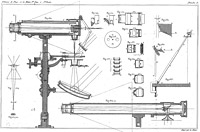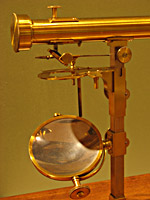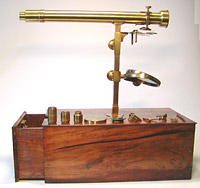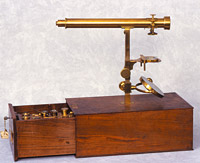Instruments
Catadioptric Microscope
Amici presented his first catadioptric microscope at the Arts and Industry Exhibition in Milan in 1812 together with a reflecting telescope. Both were declared worthy of the highest prize by the Commission of the Science Institute.
Amici had conceived of it as an inverse application of a Newtonian telescope, guided by the idea that “from a telescope of any form one could create a microscope by simply putting the object where one’s eye goes in the telescope and the eyepiece where the object is in the telescope” (Giovanni Battista Donati, Elogio del Prof. Gio. Battista Amici, Cellini, Florence 1865, pp. 6-7).
The optical part of the instrument “consists of a concave ellipsoidal reflector with an aperture of about an inch and a focal length (first focus) of two inches. Along the axis of this mirror at about half of its focal distance there is a small plane reflector, obtained from the section of a small cylinder, inclined at 45° from the axis of the instrument, as in a Newtonian telescope. The object to be observed is placed on a m oveable stage and placed in the focus of the concave mirror. At the other end [...] of the horizontal tube of the microscope there is the second focus. Its focal distance is 12 inches”. The eyepieces are of the Ramsden type, composed by two convex-plane lenses. The elliptical mirror “is carefully worked on with a copper-tin alloy, very rich in tin [...] This is the type of alloy [...] which guarantees the greatest value to the Amici microscope” in contrast to the “copper mirrors, always affected by oxidation” (Giorgio Dragoni, G.B. Amici: Il microscopio a riflessione. Anticipazioni storiche, caratteristiche tecniche < G.B. Amici: The reflecting microscope. Historic advances, technical characteristics >, “Giornale di Fisica”, 2/3-1988, p. 151-153). Even the large, 8cm-diameter illuminating mirror “is not a simple mirror of silvered glass [...] but a mirror made by fusing the same alloy used for the ellipsoidal mirror” (ibid).
oveable stage and placed in the focus of the concave mirror. At the other end [...] of the horizontal tube of the microscope there is the second focus. Its focal distance is 12 inches”. The eyepieces are of the Ramsden type, composed by two convex-plane lenses. The elliptical mirror “is carefully worked on with a copper-tin alloy, very rich in tin [...] This is the type of alloy [...] which guarantees the greatest value to the Amici microscope” in contrast to the “copper mirrors, always affected by oxidation” (Giorgio Dragoni, G.B. Amici: Il microscopio a riflessione. Anticipazioni storiche, caratteristiche tecniche < G.B. Amici: The reflecting microscope. Historic advances, technical characteristics >, “Giornale di Fisica”, 2/3-1988, p. 151-153). Even the large, 8cm-diameter illuminating mirror “is not a simple mirror of silvered glass [...] but a mirror made by fusing the same alloy used for the ellipsoidal mirror” (ibid).
 Improved over the next few years, this instrument met with unanimous international favour. In fact, John Quekett wrote, in his Practical treatise on the use of the microscope (1848): “a new and most important æra in microscopic science commenced in this country [England] with the improvement in the reflecting microscope, constructed by Amici in 1815”.
Improved over the next few years, this instrument met with unanimous international favour. In fact, John Quekett wrote, in his Practical treatise on the use of the microscope (1848): “a new and most important æra in microscopic science commenced in this country [England] with the improvement in the reflecting microscope, constructed by Amici in 1815”.
Amici himself immediately used this microscope to observe the circulation of the sap in the Chara. Hugo von Mohl wrote, in 1863, that “this microscope provided sharp images and magnifying power far beyond any of the other microscopes which were available then, and it would have been much more useful for Science had it been better known by more people and had it been invented in a period in which willingness and ability in microscopic research were not so rare.” (Hugo von Mohl, Giambattista Amici, “Botanische Zeitung”, n. 51-1863, p. 4; Italian translation by A. Meschiari, “Atti della Fondazione Giorgio Ronchi”, 2-1999, p. 210).
 In 1818 Amici presented his paper De’ microscopj catadiottrici (On catadioptric microscopes), to the Italian Society of Sciences, published in Vol. XVIII-1820 of the “Memorie di Matematica e di Fisica” (download pdf).
In 1818 Amici presented his paper De’ microscopj catadiottrici (On catadioptric microscopes), to the Italian Society of Sciences, published in Vol. XVIII-1820 of the “Memorie di Matematica e di Fisica” (download pdf).
Vincent Chevalier, who constructed Amici’s camera lucida prior to 1827, began preparing his catadioptric and achromatic microscopes as well after Amici’s trip to Paris. It seems though, that Amici furnished him directly with the elliptical mirror since this was difficult to make.
In fact, Chevalier wrote Amici in his Paris hotel on 23 May 1827: “Quant à la bonté que vous avez en nous promettant de nous admettre à l’honneur de la construction de votre excellent microscope, nous vous reïterons, Monsieur, que c’est avec le plus grand plaisir que nous y mettrons toute l’exactitude et la célérité dont nous serons capables et que nous ferons avec vous, Monsieur, tous les arrangemens d’intérêt qui pourront vous être agréables. Pour ce qui est relatif à la fourniture des pièces essentielles (le fameux miroir Elliptique), dessins, modèles, Mémoires etc. vous aurez la bonté de nous les fournir” (cf. A. Meschiari, Corrispondenza di G. B. Amici con ottici e meccanici < Buron, Chevalier, Duboscq, Ertel, Fraunhofer, Guinand e Feil, Hartnack, Lerebours, Merz, Nachet, Oberhaeuser >, “Atti della Fondazione Giorgio Ronchi”, 4/5-2000, p. 527).
Amici’s Workshop Account Book registers some of the purchasers of the catadioptric microscope as:
 - Count Girolamo Bardi, Director of the Florence Museum of Physics and Natural History (1819)
- Count Girolamo Bardi, Director of the Florence Museum of Physics and Natural History (1819)
- Archduchess Maria Luigia of Parma (1819)
- The Prince of Metternich (1821)
- Emperor of Russia through the Archduke Maximilian (1822)
- the Geneva Physicist Marc-Auguste Pictet (1822)
- William Henry Fox Talbot (1822)
- the Physics laboratory of the University of Modena (1825)
- probably Alexander von Humboldt with the intermediation of Pictet (1825)
- Jean-Louis Prévost of Geneva (1826)
The Physics Museum of the University of Prague had a catadioptric microscope from Amici as early as 1817, purchased by the Physics professor Cassian Halaschka. Ian Evangelista Purkyne studied in Prague at that time, and remained there as an assistant professor in Anatomy and Physiology from 1819 to 1823, when he was invited to Breslau.
Amici’s Catadioptric Microscope for Prof. Dal Negro of Padua (1824)
Amici’s Workshop Account Book registers in April 1824 “a microscope to Pr of Padua” for 560 francs. The purchaser was Salvatore Dal Negro (1768-1839), professor of Experimental Physics at the University of Padua, and the technical sheet of one of these instruments bears his name. The microscope was ordered in November of 1823 and is still kept at the Museum of the History of Physics in Padua.
Magnification |
1st eyepiece |
52 times in diameter |
2nd |
98 |
|
3rd |
140 |
|
4th |
277 |
|
5th |
554 |
|
6th |
1141 |
Amici’s Catadioptric Microscope for Dr. Carlo Passerini, Curator at the Museum of Florence (1824)
Amici’s Workshop Account Book registers 560 francs in July 1824 as payment for a catadioptric microscope sold to Dr. Carlo Passerini of Florence. Passerini was at first Associate Professor of Comparative Anatomy and Zoology and then Curator at the Museum of Physics and Natural History.
The instrument can still be seen at the Institute and Museum of the History of Science in Florence (cf. the Catalogue of microscopes of this Institute, ed. by Gerard L’E. Turner, Giunti, Florence 1991: Reflecting microscope n. 82).
Technical Sheet
Magnification |
1st eyepiece |
53 times in diameter |
2nd |
86 |
|
3rd |
117 |
|
4th |
374 |
|
5th |
503 |
|
6th |
1115 |
 Courtesy of Mr. Brian Davidson
Courtesy of Mr. Brian Davidson


